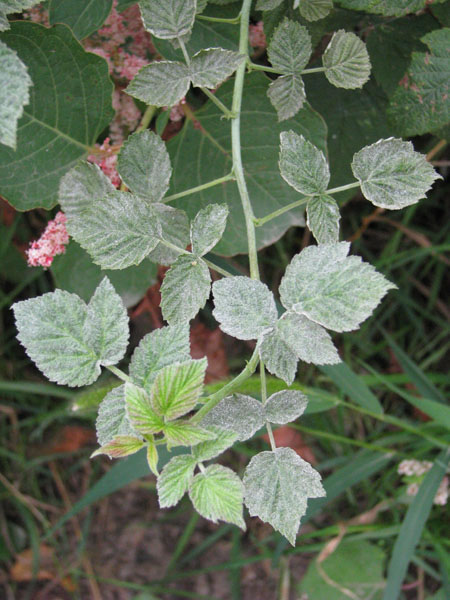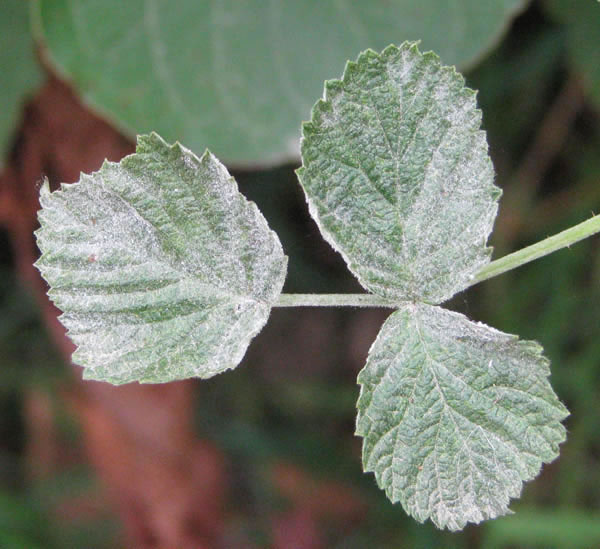
Powdery Mildew
Sphaeroteca Macularis / Podosphaera Aphanis
Pathogen:
Fungus
Type:
Risk:
INTERMEDIATE
Oídio
Frambuesa


WHO CAUSES IT?
Sphaerotheca macularis and Podosphaera aphanis are fungi that cause powdery mildew in raspberries. These pathogens belong to the group of ascomycetes and their development begins with the production of conidia under favorable conditions of humidity and temperature. The conidia are dispersed by the wind and when they find a susceptible host, they germinate on its surface, producing a germinative hypha that penetrates the cuticle of the leaves. In plant tissue, fungi develop a superficial mycelium that extracts nutrients from the plant through haustoria. During the dormant period, they produce resistance structures called cleistothecia, which contain ascospores and allow them to survive in plant remains until the next growing season. The germination of these structures in spring marks the beginning of a new cycle of infection.
SYMPTOMS
Powdery mildew on raspberries caused by Sphaerotheca macularis and Podosphaera aphanis is characterized by a white, powdery coating that covers the surface of leaves, young shoots and fruits. This disease affects photosynthesis and fruit quality, significantly reducing crop yield. Infected leaves may become deformed and chlorotic, while young shoots become twisted and brittle.
- Appearance of a white powder on the leaves, shoots and fruits.
- Deformation and chlorosis of the leaves.
- Delay in the growth and development of shoots.
- Necrosis on the margins of the leaves.
- Fruits with a dusty and deformed appearance.
- Reduction in the quality and size of the fruits.

TEMPERATURE AND HUMIDITY
15°C - 25°C
50% - 70%
TRANSMISSION ROUTES
Wind, contaminated tools, infected plant remains, contaminated nursery plants
Do you want to remove this pest? Choose how you want to treat it.
TREATMENTS
Chemical treatments
• ORANGE OIL 6% [SL] P/V
• ORANGE OIL 60g/L [ME] P/S
• SULFUR 70% [SC] P/V
• SULFUR 72% [SC] P/V
• SULFUR 80% [WG] P/P
• BUPIRIMATE 25% [EC] P/V
• COS-OGA 1.25% [SL] P/V
• DIFENOCONAZOLE 25% [EC] P/V
• POTASSIUM HYDROGEN CARBONATE 0.425% [AL] P/V
• POTASSIUM HYDROGEN CARBONATE 85% [SP] P/P
• POTASSIUM HYDROGEN CARBONATE 99% [SP] P/P
• PENCONAZOLE 20% [EW] P/V
• PIRACLOSTROBIN 6.7% + BOSCALIDE 26.7% ( ) [WG] P/P
Authorized treatments in organic farming
• ORANGE OIL 6% [SL] P/V
• ORANGE OIL 60g/L [ME] P/S
• SULFUR 70% [SC] P/V
• SULFUR 72% [SC] P/V
• SULFUR 80% [WG] P/P
• COS-OGA 1.25% [SL] P/V
• POTASSIUM HYDROGEN CARBONATE 0.425% [AL] P/V
• POTASSIUM HYDROGEN CARBONATE 85% [SP] P/P
• POTASSIUM HYDROGEN CARBONATE 99% [SP] P/P
Biological control
• BACILLUS SUBTILIS (STRAIN QST 713) 1.34% [SC] P/V
Recommendations
- Use raspberry cultivars resistant to powdery mildew.
- Implement an appropriate crop rotation, avoiding planting raspberries in previously affected areas.
- Improve air circulation in the crop by regularly pruning shoots and removing old leaves.
- Avoid excess nitrogen fertilization that can favor exuberant growth and susceptibility to powdery mildew.
- Apply preventive and curative fungicides according to technical recommendations and crop conditions.
- Water the plants appropriately, avoiding overhead irrigation that keeps moisture in the leaves.
- Monitor the crop regularly to detect early symptoms and apply treatments in a timely manner.
- Eliminate and destroy infected plant remains to reduce the inoculum in the field.
- Practice adequate disinfection of agricultural tools and equipment to prevent the spread of the pathogen.
Sponsored link
Sponsored link
Sponsored link
Sponsored link
Sponsored link
Sponsored link
Effective against all types of fungi
TREATMENTS
Homemade remedies
There are no home treatments
Natural allies
Chemical treatments
There are no treatments for this disease. Treatments are directed at the insect vectors that transmit it. See insect treatments.
RECOMMENDATIONS
- Check the back of the leaves frequently, especially in dry weather.
- Spray water on the leaves to increase humidity and prevent them from settling.
- Keep plants healthy with good watering and adequate light.
- If you see cobwebs or damage, clean the leaves with a damp cloth or pressurized water.
- Use potassium soap or neem oil every few days until they disappear.
REPELLENT PLANTS
Rosemary, Dill, Coriander
EFFECTIVE PRODUCTS TO ELIMINATE THIS PEST
Sponsored link
Sponsored link
Sponsored link
Sponsored link
Sponsored link
Sponsored link
Effective against all types of fungi
*The recommended treatments are recommendations based on the authorities' databases and do not replace in any way the guidelines established by the legislation of each country.
*Products shown are recommendations and not our own products. As Amazon Associates, we earn revenue from purchases of recommended products.






















